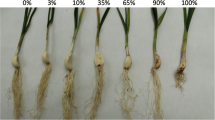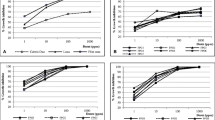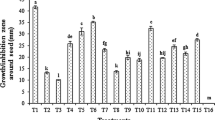Abstract
The fungus Fusarium oxysporum f. sp. medicaginis (Fom), as verified following Koch’s postulates, was isolated from diseased alfalfa plants, cv. Yliki, in Greece. The susceptibility of eight most cultivated in Greece alfalfa and two clover cultivars was tested using seedlings that were artificially inoculated according to the root-dipping method. All alfalfa cultivars were susceptible to Fom, while the fungus was non pathogenic to clover cultivars. The effectiveness of the biological agents 4F3 (nit mutant of non-pathogenic F. oxysporum isolate) and 618–12B17 (non-pathogenic benomyl resistant F. oxysporum mutant), the chemical substances ß-aminobutyric acid and Bion and fungicide carbendazim was evaluated regarding disease control. Disease incidence was suppressed in association with carbendazim, 4F3, 618–12B17 and Bion treatments.
Zusammenfassung
Der anhand von Koch’s Postulaten identifizierte Pilz Fusarium oxysporum f. sp. medicaginis (Fom) wurde aus infizierten Luzernepflanzen der Sorte Yliki in Griechenland isoliert. Die Anfälligkeit der acht verbreitetsten Luzernesorten Griechenlands und zweier Kleesorten gegenüber dem Pilz wurde mit der Wurzeltauchmethode untersucht. Während alle Luzernesorten anfällig gegenüber Fom waren, war der Pilz gegenüber den beiden Kleesorten nicht pathogen. Die Effizienz der Antagonisten 4F3 (nit-Mutante eines nicht-pathogenen F.-oxyspo- rum-Isolats) und 618-12B17 (nicht-pathogene Benomyl-resis- tente F.-oxysporum-Mutante), der chemischen Substanzen ß-Aminobuttersäure und Bion sowie des Fungizids Carbenda- zim wurde hinsichtlich einer Kontrolle der Erkrankung untersucht. Die Befallshäufigkeit sank gegenüber der Kontrolle nach Behandlungen mit 4F3, 618–12B17 und Bion.
Similar content being viewed by others
Literature
Alabouvette, C., Y. Couteaudier, 1992: Biological control of Fusarium wilt with nonpathogenic Fusaria. In: E.C. Tjamos, G. C. Papavizas, R.J. Cook (eds.): Biological Control of Plant Diseases, pp. 415–426. Plenum Press, New York, USA.
Anfoka, F.H., 2000: Benzo-(1,2,3)-thiadiazole-7-carbothioic acid S-methyl ester induces systemic resistance in tomato (Lycopersicon esculentum Mill. cv. Vollendung) to Cucumber Mosaic Virus. Crop Prot. 19, 401–405.
Antonopoulos, D.F., K. Elena, E.C. Tjamos, 2003: First report of Fusarium wilt of alfalfa in Greece. Plant Dis. 87, 751.
Armstrong, G.M., J.K. Armstrong, 1954: Alfalfa-A common host for the wilt Fusaria from alfalfa, cotton and cassia. Plant Dis. Rep. 38, 221–222.
Armstrong, G.M., J.K. Armstrong, 1965: Further studies on the pathogenicity of three forms of Fusarium oxysporum causing wilt of alfalfa. Plant Dis. Rep. 49, 412–416.
Bao, J.R., G. Lazarovits, 2001: Differential colonization of tomato roots by nonpathogenic and pathogenic Fusarium oxysporum strains may influence Fusarium wilt control. Phytopathology 91, 449–456.
Benhamou, N., R.R. Belanger, 1998: Benzothiadazole-mediat- ed induced resistance to Fusarium oxysporum f. sp. radicis-ly- copersici in tomato. Plant Physiol. 118, 1203–1212.
Campbell, C.L., L.V. Madden, 1990: Introduction to Plant Disease Epidemiology. John Wiley & Sons Inc., New York.
Cohen, Y., 1994: ß-aminobutyric acid induces systemic resistance against Peronospora tabacina. Physiol. Mol. Plant Pathol. 44, 273–288.
Cole, D.L., 1999: The efficacy of acibenzolar-S-methyl, an inducer of systemic acquired resistance, against bacterial and fungal diseases of tobacco. Crop Prot. 18, 267–273.
Corell, J.C., C.J.R. Klittich, J.F. Leslie, 1987: Nitrate nonutilizing mutants of Fusarium oxysporum and their use in vegetative compatibility tests. Phytopathology 77, 1640–1644.
Davidse, L.C., 1986: Benzimidazole fungicides: mechanisms of action and biological impact. Annu. Rev. Phytopathol. 24, 43–65.
Elena, K., E.J. Paplomatas, C. Lampropoulos, 2001: Biological control of Fusarium oxysporum f. sp. dianthi using nonpathogenic strains of F. osysporum. Proceedings, Ninth Hellenic Phytopathological Conference, Athens Greece 20–22 October 1998: Phytopathol. Medit. 40, 93.
Emberger, G., R.E. Welty, 1983: Evaluation of virulence of Fusarium oxysporum f. sp. medicaginis and Fusarium Wilt resistance in alfalfa. Plant Dis. 67, 94–98.
Erwin, D.C., 1990: Fusarium wilt. In: D. Studevill, D.C. Erwin (eds.): Compendium of alfalfa diseases, pp 33–34. Second edition. Phytopathological Society, St. Paul, MN, USA.
Frosheiser, F.I., D.K. Barnes, 1978: Field reaction of artificially inoculated alfalfa populations to the Fusarium and Bacterial wilt pathogens alone and in combination. Phytopathology 68, 943–946.
Garibaldi, A., F. Brunatti, M.L. Gullino, 1987: Evaluation of several antagonists and different methods of application against Fusarium wilt of Carnation. EPPO Bull. 17, 625–629.
He, C.Y., T. Hsiang, D.J. Wolyn, 2002: Induction of systemic disease resistance and pathogen defense responses in Asparagus officinalis inoculated with nonpathogenic strains of Fusarium oxysporum. Plant Pathol. 51, 225–230.
JENKINS, J.H., G.D. LINDBERG, 1961: Fusarium wilt of alfalfa in Louisiana. Southern Division Report and Abstracts, 643.
Kessmann, H., T. Stau, C. Hofman, T. Maetzke, J. Herttzog, E. Ward, S. Uknes, J. Ryals, 1994: Induction of systemic acquired disease resistance in plants by chemicals. Annu. Rev. Phytopathol. 32, 439–459.
Korolev, N., E. Pèrez-Artèz, J. Bejarano-Alcázar, D. Rodríguez-Jurado, J. Katan, T. Katan, R.M. Jimènez-Duípaz, 2001: Comparative study of genetic diversity and pathogenicity among populations of Verticillium dahliae from cotton in Spain and israel. Eur. J. Plant Pathol. 107, 443–456.
Larkin, R.P., D.R. Fravel, 1999: Field efficacy of selected non-pathogenic Fusarium spp. and other biocontrol agents for control of Fusarium wilt of tomato. Biol. Cult. Tests 14, 116.
Larkin, R.P., D.R. Fravel, 2002: Effects of varying environmental conditions on biological control of Fusarium wilt of tomato by non-pathogenic Fusarium spp. Phytopathology 92, 1160–1166.
Lawton, K.A., L. Friedrich, M. Hunt, K. Weymann, T. Delaney, H. Kessmann, T. Staub, J.A. Ryals, 1996: Benzothiadazole induces disease resistance in Arabidopsis by activation of the systemic acquired resistance signal transduction pathway. Plant J. 10, 71–82.
Leath, K.T., 1993: Interaction of Fusarium oxysporum f. sp. medicaginis with feeding activity of clover root curculio larvae in alfalfa. Plant Dis. 77, 799–802.
Mauch-Mani, B., J.-P. Métraux, 1998: Salicylic acid and systemic acquired resistance to pathogen attack. Ann. Bot. 82, 535–540.
Oostendorp, M., W. Kunz, B. Dietrich, T. Syaub, 2001: Induced disease resistance in plants by chemicals. Eur. J. Plant Pathol. 107, 19–28.
Postma, J., H. Rattink, 1992: Biological control of Fusarium wilt of carnation with nonpathogenic isolate of Fusarium oxysporum. Can. J. Bot. 70, 1199–1205.
Puhalla, J.E., 1985: Classification of strains of Fusarium oxysporum on the basis of vegetative compatibility. Can. J. Bot. 63, 179–183.
Rouxe, F., D. Bouhot, 1971: Recherches sur l’ ecology des champignons parasites dans le sool. IV. Nouvelles mises au point concernant l’ analyse sélective et quantitative des Fusarium oxysporum et F. solani dans le sol. Ann. Phytopathol. 3, 171–188.
Siegrist, J., M. Orober, H. Buchenauer, 2000: ß-aminobutyric acid-mediated enhancement of resistance in tobacco to tobacco mosaic virus depends on the accumulation of salicylic acid. Physiol. Mol. Plant Pathol. 56, 95–106.
Sinha, A.K., R.K.S. Wood, 1968: Studies on the nature of resistance in tomato plants to Verticillium albo-atrum. Ann. Appl. Biol. 62, 319–327.
Snyder, W.C., H.N. Hansen, 1940: The species concept in Fusarium. Am. J. Bot. 27, 65–67.
Stephens, C.T., W.H. Elmer, 1988: Comparison of techniques for eliminating contaminants from asparagus seeds. HortScience 23, 1031–1032.
Sticher, L., B. Mach-Mani, J.-P. Métraux, 1997: Systemic acquired resistance. Annu. Rev. Phytopathol. 35, 235–270.
Tamietti, G., R. Pramotton, 1987: Une méthode très simple de sélection de souches de Fusarium spp. non pathogenes, antagonistes des fusarioses vasculaires. EPPO Bull. 17, 549–557.
Weimer, J.L., 1928: A wilt disease of alfalfa caused by Fusarium oxysporum var. medicaginis. J. Agric. Res. 37, 419–433.
Author information
Authors and Affiliations
Corresponding author
Rights and permissions
About this article
Cite this article
Antonopoulos, D.F., Elena, K. Susceptibility of Greek alfalfa and clover cultivars to Fusarium oxysporum f. sp. medicaginis and potential methods of disease control. J Plant Dis Prot 115, 162–166 (2008). https://doi.org/10.1007/BF03356260
Received:
Accepted:
Published:
Issue Date:
DOI: https://doi.org/10.1007/BF03356260




